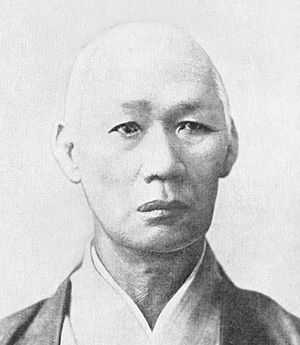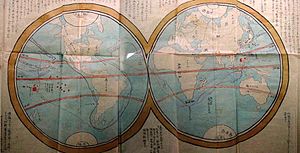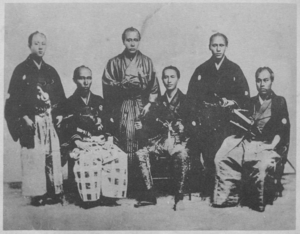Nakahama Manjirō facts for kids
Quick facts for kids
Nakahama Manjirō
中濱 万次郎 |
|||||
|---|---|---|---|---|---|

Nakahama "John" Manjirō
|
|||||
| Born | January 27, 1827 |
||||
| Died | November 12, 1898 (aged 71) |
||||
| Nationality | |||||
| Other names | John Mung | ||||
| Japanese name | |||||
| Kanji | 中濱 万次郎 | ||||
| Hiragana | なかはま まんじろう | ||||
|
|||||
Nakahama Manjirō (born January 27, 1827 – died November 12, 1898) was a very important Japanese person. He was also known as John Manjirō or John Mung. He was one of the first Japanese people to travel to the United States. Manjirō played a key role as a translator when Japan opened its doors to the world during the Perry Expedition.
Contents
Manjirō's Amazing Journey to America
When he was young, Manjirō lived as a simple fisherman in a village called Naka-no-hama. This village was in Tosa Province, which is now Tosashimizu, Kōchi.
Shipwreck and Rescue
In 1841, when Manjirō was 14 years old, he went fishing with four friends. Their boat was wrecked on a small island called Torishima. Luckily, an American whaling ship named John Howland found them. The ship's captain, William H. Whitfield, rescued Manjirō and his friends.
At the end of the voyage, four of Manjirō's friends stayed in Honolulu. But Manjirō, who was nicknamed "John Mung," wanted to stay on the ship. Captain Whitfield took him to the United States.
Life and Learning in America
In America, Captain Whitfield helped Manjirō. He enrolled Manjirō in the Oxford School in Fairhaven, Massachusetts. Manjirō studied English and navigation for a year. He also learned how to be a cooper, someone who makes barrels.
After this, Manjirō joined another whaling ship called the Franklin. He sailed the South Seas and even became a boatsteerer, which meant he was in charge of throwing the harpoon. In October 1847, the Franklin stopped in Honolulu. There, Manjirō met his four friends again.
At this time, Japan was in a period of isolation. This meant that leaving the country was a crime, and people could be punished by death. So, Manjirō and his friends could not go back home yet.
Gold Rush Adventure
In September 1849, the Franklin returned to New Bedford, Massachusetts. Manjirō had saved $350, which was a lot of money back then. He decided to try his luck in the California Gold Rush.
He arrived in San Francisco in May 1850. He traveled up the Sacramento River and into the mountains. In just a few months, he found enough gold to get about 600 silver coins. With this money, he decided it was time to find a way back to Japan.
Returning Home to Japan
Manjirō went back to Honolulu. Two of his friends decided to join him on the journey back to Japan. (One friend, Toraemon, thought it was too dangerous, and another, Jusuke, had passed away.)
Manjirō bought a small whaleboat called the Adventure. This boat was loaded onto a larger ship, the Sarah Boyd. They also brought gifts from the people of Honolulu. They set sail on December 17, 1850.
Arrival and Questioning
On February 2, 1851, they reached Okinawa, which is part of Japan. They were immediately taken into custody. Even though they were treated politely, they were questioned for many months.
Finally, they were released in Nagasaki. Eventually, they made it back to their home in Tosa. The local lord, Yamauchi Toyoshige, gave them pensions. Manjirō was given a small official job and became a very important source of information.
Becoming a Samurai
In September 1853, Manjirō was called to Edo, which is now Tokyo. The shogunate government, which ruled Japan, questioned him. They were so impressed that they made him a hatamoto. This meant he was a samurai who served the shōgun directly.
From then on, Manjirō would only share information with the government. To show his new status, he was allowed to wear two swords. He also needed a family name, so he chose Nakahama, named after his home village.
In 1861, Manjirō was asked to join a government trip to the Bonin Islands. He worked as an interpreter on this trip.
Manjirō's Service as a Hatamoto
Manjirō wrote a detailed report about his travels for the Tokugawa Shogunate. This report is still kept today at the Tokyo National Museum.
Helping Open Japan
On July 8, 1853, Commodore Matthew C. Perry arrived in Japan with his "Black Ships". He came to force Japan to open up to the world. Manjirō became a translator for the Shogunate. He played a key role in the talks that led to the Convention of Kanagawa, an important agreement. However, it seems he did not speak directly with the Americans at that time.
Trans-Pacific Voyage
In 1860, Nakahama Manjirō was part of the first Japanese Embassy to the United States (1860). He was the translator on board the Kanrin Maru. This was Japan's first modern, screw-driven steam warship.
Because Japan had been isolated for so long, the crew didn't have much experience sailing in the open ocean. During a big storm, many of the crew members, including the captain, became very sick. Manjirō took charge and safely guided the ship to port.
Later Life and Teaching
In 1870, during the Franco-Prussian War, Manjirō went to Europe to study military science. He returned to Japan by way of the United States. He was officially welcomed in Washington D.C. He used this chance to travel overland to Fairhaven, Massachusetts. There, he visited his "foster father," Captain Whitfield.
Eventually, Manjirō became a professor at the Tokyo Imperial University.
Manjirō's Lasting Legacy
Manjirō used his knowledge of Western shipbuilding to help Japan build a modern navy. He translated an important navigation book, Bowditch's American Practical Navigator, into Japanese. He also taught English, naval tactics, and whaling techniques. It is believed he helped build the Shohei Maru, Japan's first foreign-style warship after its isolation.
Manjirō was married three times and had seven children. In 1918, his oldest son, Dr. Nakahama Toichirō, gave a valuable sword to Fairhaven. This was a gift to thank the town for rescuing his father and for their kindness. The sword was displayed in the town library even during World War II, when feelings against Japan were very strong. After the sword was stolen in 1977, a new one was given in 1982. It is still on display at the library today.
Among his many achievements, Manjirō was likely the first Japanese person to ride a train, travel on a steamship, become an officer on an American ship, and command a ship across the Pacific Ocean.
There is a statue of Nakahama Manjirō at Cape Ashizuri, on Shikoku island. Sadly, his grave in Tokyo was destroyed by American air raids during World War II. In Fairhaven, the Manjirō Historic Friendship Society has made Captain William Whitfield's home into a museum. It tells the story of Manjirō's life and his connection to the town.
A small planet, 4841 Manjiro, is named after him.
Many books have been written about Manjirō's life and adventures. Some popular ones include Heart of a Samurai by Margi Preus, Born in the Year of Courage by Emily Crofford, and Shipwrecked! The True Adventures of a Japanese Boy by Rhoda Blumberg.
A special Manjiro Festival is held in Fairhaven in early October of odd-numbered years. It is sponsored by the Whitfield-Manjiro Friendship Society.
See also
 In Spanish: Nakahama Manjirō para niños
In Spanish: Nakahama Manjirō para niños
- Hasekura Tsunenaga, one of the first recorded Japanese to reach the Americas, in 1614
- Tanaka Shōsuke, one of the first recorded Japanese to reach the Americas, in 1610
- Christopher and Cosmas, one of the first recorded Japanese to reach the Americas, as early as 1587
- Otokichi, a famous Japanese castaway to the British and American controlled Oregon Territory in 1834
- Moriyama Einosuke, another translator in the negotiation with Perry
- Ranald MacDonald, the first teacher of English in Japan (Moriyama Einosuke was one of MacDonald's students in Nagasaki in 1848)
- Shimazu Nariakira
- Joseph Heco, the first Japanese person to be naturalized as a United States citizen, in 1858
- Pacific Overtures, Stephen Sondheim and John Weidman's unconventional musical about the arrival of the black ships in Japan. Manjiro is a major character in it, although his story is highly dramatized.



